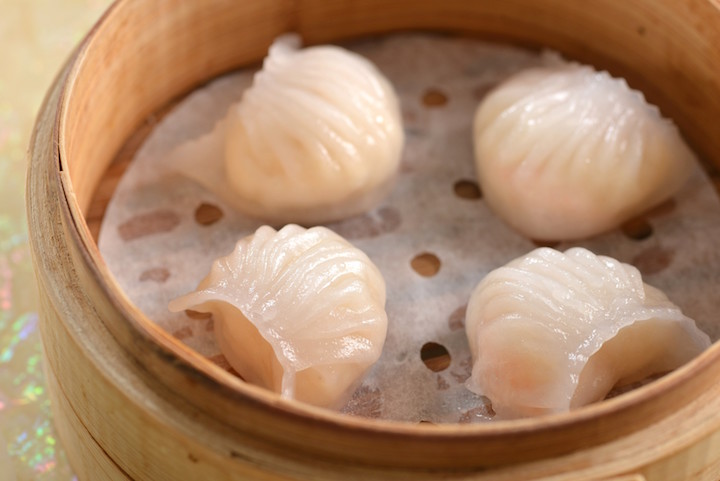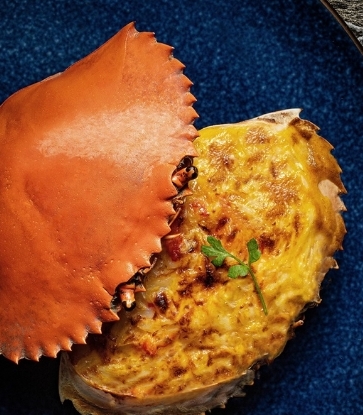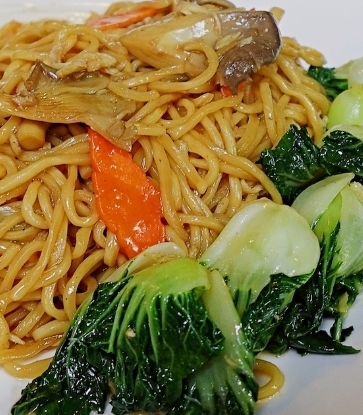As teahouses in its original form faded out of the society, the modern derivatives Lin Heung and Luk Yu turned Cantonese dim sum into a symbol of local dining culture. The former launched street favourites pork liver siu mai, dai bao (large steamed bun), chicken and duck wrap in oyster sauce; while the latter invented more refined classics like fried Chiu Chow dumplings served with broth, and steamed fresh pork ribs in Chu Hou bean paste. Though catering to different strata of society, these vintage teahouses manifest the universal love and thoughtfulness to food in Hong Kong.

Har gow is undisputedly the most well-known type of dim sum to epicures around the world. The dumpling’s humble size hides the level of craftsmanship. A good har gow should appear like a half moon with 12-13 folds on the skin. Thin skins and quality fillings are the golden standard for dim sum that every Hong Konger swears by. Chef Lai-Yin Wong from Cuisine Cuisine, the Mira Hotel said the dough made with water starch has a sticky and spongy texture which makes it hard to cut with a mould. Experienced cooks make an air-thin skin in just one slap with the side of a cleaver.
“As for the shrimp, we preferred river shrimp in the past for a stronger umami. Now we’ve replaced it with a more crisp variety from Shanghai,” says Wong. The ideal har gow filling contains 30 per cent raw shrimp, 20 per cent cooked shrimp and pork with a good amount of fat. People nowadays avoid fat at all costs, but according to Wong, it brings out the best of the shrimp and bamboo shoot in the dumpling.
Siu Mai made with hand-cut pork
The executive chef of Mott 32 Lee Man Sing created siu mai with hand-cut pork, which lends a richer texture to the dish. To make good enough har gow and siu mai, Wong and Lee both said it could be a task of one or two years. Wong said the dim sum restaurants of the old days operated on high efficiency. They turned out 600 plates of pork ribs filling 30 large steamers in just one morning.

Dim sum nowadays has progressed to a new age thanks to the chefs’ creativity. For instance, Cuisine Cuisine got positive reception for its porcini cheung fun (steamed rice roll), abalone siu mai and barbecued wagyu beef bun.
Speciality Dim Sum Restaurant Marks a New Era
The rise of dim sum restaurants in recent years introduced a new experience – quick service and affordable prices while maintaining hotel quality. The leading figure of the trend is Tim Ho Wan. Its owner Kwai-Pui Mak worked in a five-star hotel before founding his multi-national venture.
“We tried to make creative dim sum in the Sham Shui Po branch for a couple years. It was more difficult to master foreign ingredients, and the guests didn’t respond greatly either. At that point, we decided to return to what we do best,” Mak says.

In recent months, night-time yum cha places have been coming back into fashion, thanks to China Tang in Tsim Sha Tsui. Dim Sum Executive Chef Yiu-Po Wong gained a following with his xiao long bao and milk curd pudding with taro.
“Modern diners value newness and refinement,” he explains. “We need to look ahead for ideas while basing ourselves on traditional techniques. The kimchi seafood dumpling is one good example [as we wanted] to capture the hype of the Korean Wave.”
Chinese Executive Chef Leung Fai Hung from InterContinental Hong Kong insists that even though Western ingredients are seen more frequently on the dim sum menu, there are still traditional cooking skills that cannot be overlooked.
“Dim sum encapsulates entire regular dishes. Accuracy becomes very important because every small mistake is amplified,” he says. “Every plate is a gesture of heart and mind.”
Invention, in his eyes, is 60 per cent dictated by the preference of the guests. Chefs take a more passive role. But whatever the dish is, the heart and mind doesn’t change. For diners who don’t get to see the kitchens and behind the scenes, what’s in the steamer says everything about the restaurant.
Restaurant Recommendations
Cuisine Cuisine
Address: 3/F, The Mira Hong Kong, Miramar Shopping Centre, 118-130 Nathan Road, Tsim Sha Tsui
Tel: 2315 5222
Cuisine Cuisine takes a contemporary approach in dim sum, famous for abalone and prawn siu mai, snow crab and cheese spring roll, barbecued wagyu beef bun and inventive delicacies.
Mott 32
Address: Standard Chartered Bank Building, 4-4A Des Voeux Road Central, Central
Tel: 2885 8688
Apple wood-smoked Peking duck and stewed thin-sliced beef are among the favourites of Mott 32, but don’t miss chef Lee’s hand-cut pork siu mai.
China Tang (Tsim Sha Tsui)
Address: Shop 4041, 4/F, The Gateway, Harbour City, 17, Canton Road, Tsim Sha Tsui
Tel: 2157 3148
A specialist in Shanghainese and Sichuan cuisine, Cantonese dim sum is a new introduction to the joint. The night-time yumcha promotion, the aforementioned xiao long bao and milk curd pudding with taro are big draws to those exploring new dim sum locations.
Hoi King Heen
Address: B2/F, InterContinental Hong Kong, 70 Mody Road, Tsim Sha Tsui
Tel: 2731 2883
Led by Chinese Executive Chef Fai-Hung Leung, the restaurant was rewarded one Michelin star status between 2011 and 2013. Its signature dim sum dishes including premium har gow, crab roe and scallop siu mai, as well as rice cake all receive favourable reviews.
Tim Ho Wan
Address: G/F, 9-11 Fook Wing Street, Sham Shui Po
Tel: 2788 1226
After eight years of running and opening branches overseas, the reach of the Tim Ho Wan Empire is the highest ever. The restaurant’s offerings qualify as the food of the people, with pork liver steamed rice roll, tofu skin roll and crispy barbecued pork bun becoming the new generation of dim sum classics.





















